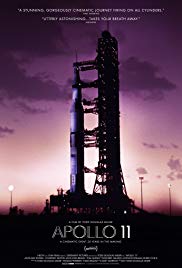
APOLLO 11
US, 2019, 93 minutes, Colour.
Directed by Todd Douglas Miller.
There will be two quite different responses to this documentary, released at the time of the 50th anniversary of the Apollo 11 mission to the moon, the astronauts, ‘the eagle has landed’, stepping on to the surface of the moon, the urging of John F. Kennedy in 1961 to have a vision of such a mission within the decade – and its achievement.
For audiences 60 and over, the experience of the film will be reminiscing, where we were the day of the moon landing, what happened, our responses, the expectations of space exploration, anticipation of the moon landing and the wonder of its achievement. For audiences under 60, there is no actual memory of the experience. Rather, this is a looking back into history, wonder at what was achieved at the time, comparisons with what happened afterwards and what is happening in the present, further missions to the moon, achievements in the future.
A lot of this material has not been seen before. It was stored in archives, well preserved, and the film archivist has a great deal of footage to draw on and has judiciously chosen material that, within the space of 90 minutes or so, enables audiences to experience the mission from day one to day six, the eventual splashdown of the three astronauts, mission accomplished.
One word that comes to mind in the early part of the film is “vast�. It is not the vastness of the enterprise itself but the initial impact of the plant in Cape Canaveral, Florida, as well as the plant in Houston, Texas. It is extraordinary the size of the enterprise in building this station. It is the size, of course, of the spacecraft itself. It is the thousands of personnel who contributed to the building, the maintenance, the banks of experts at their desks, their consoles, giving attention to every detail. The film at the end is dedicated to the thousands who contributed in any way to the design, the building, the maintenance, the management and control.
There is footage to introduce each of the three astronauts, Neil Armstrong, Edwin “Buzz� Aldrin, Mike Collins. Their preparation is taken for granted as we see them go into the spacecraft, but the realisation of how much training, expertise, confidence and self-reliance is needed for this mission – and, with the footage over the days of the mission, seeing how expertly they carried out the details of the mission, Collins piloting the spacecraft, the Eagle landing, Armstrong setting foot on the moon, the one small step and the giant leap, Alden following, the scientific data they collected, the return of the Eagle to Colombia and the return to earth.
For 50 years, we have known the end to the mission and, so, there is not so much suspense as we watch. However, there is enough footage of the experts managing, the crowds in anticipation, the media commentary and build up so that we absorb something of the wonder and the wondering whether everything would be successful.
This is an important record of the most significant event and achievement in human enterprise. It might be time to do some cinema revision, having a look again at The Right Stuff and the initial missions in space at the end of the 1950s, beginning of the 1960s. And, there is the feature film focusing on this mission, especially on Neil Armstrong as a person, his family, Ryan Gosling playing him in Damian Chazelle’s 2018 feature, First Man.
The first moon mission could be achieved 50 years ago – with wonder, we speculate on what will happen in the next 50 years, and more…